-
 Shaelyn Fett
Shaelyn Fett Photograph of Shaelyn Fett
-
 The Night-Hag Visiting Lapland Witches
The Night-Hag Visiting Lapland Witches Painting illustrating a scene from Paradise Lost where hellhounds and night-hags are described: "follow the night-hag when, called, / In secret, riding through the air she comes, Lured with the smell of infant blood, to dance / With Lapland witches, while the laboring moon Eclipses at their charms." The night-hag (or succubus) is the focus of this painting and she is portrayed nude with grey skin and wild, unkempt hair, hovering over an infant she intends to kill or consume. She is looking over her shoulder at the lighter section of the night sky, the incoming hellhounds, and dancing witches. There are two hands holding onto a ladder and a sharp knife in the foreground.
-
 The Great Isaiah Scroll
The Great Isaiah Scroll Manuscript A of the complete Book of Isaiah (one of the seven Dead Sea Scrolls found in 1947). This scroll contains all 66 chapters and 54 columns, and is well-preserved. The excerpt from the Hebrew Bible that refers to Lilith is also visible on the scroll: “The wild-cat shall meet with the jackals and the satyr shall cry to his fellow, Yea, Lilith shall repose there and find her a place of rest” (Isaiah 34:14).
-
 Amulet for mother and newborn with the names of Lilith and the three angels
Amulet for mother and newborn with the names of Lilith and the three angels Amulet created to protect a mother and her newborn child from Lilith by evoking the three angels Senoy, Sansenoy, and Semangelof. The amulet drawing is a circular pattern with layers of writing and flower designs in black, yellow, and red. The background and center feature the color blue.
-
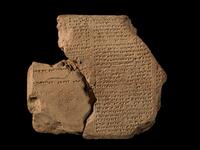 Part of Tablet VI (Epic of Gilgamesh)
Part of Tablet VI (Epic of Gilgamesh) Part of a Neo-Assyrian clay tablet inscribed with a section of Tablet VI of the Epic of Gilgamesh (written in cuneiform script). This section details a conversation between Ishtar and Gilgamesh, as well as the bull of heaven.
-
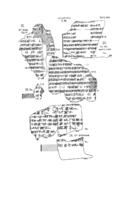 Tablet XII (Epic of Gilgamesh)
Tablet XII (Epic of Gilgamesh) A cuneiform literary tablet detailing the 12th part of the Epic of Gilgamesh, in which Lilith is referred to as a "shrieking" demoness. The picture provided is a sketched recreation of the tablet, which is broken into 6 pieces.
-
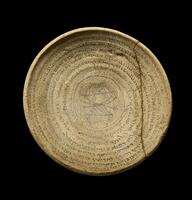 Incantation Bowl
Incantation Bowl Flat-based pottery incantation bowl with simple rim and flared wall. It is inscribed with Aramaic incantation text in a spiral from the inside to the rim, expelling demons including "liliths" (demonesses). The figure in the center might be Lilith herself, as she is often depicted on similar incantation bowls with long hair and chains to imprison her. The original client was Bahram Gushnasp, son of Ashtad Anahid.
-
 Amulet with a Lamashtu demon
Amulet with a Lamashtu demon Lamashtu, a Mesopotamian goddess, is depicted with a muscular human body, the head of a lion-griffin, and the arms of a lion, pointed upright. She is surrounded by adult animals and offerings of a spindle, a comb, and a pin. An inscription in cuneiform is written around Lamashtu and on the back of the amulet, meant to imprison her and call upon other gods to expel her. In these inscriptions she is addressed as "exalted lady." The top left corner of the obsidian amulet has broken off.
-
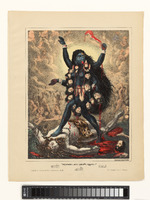 Goddess Kali
Goddess Kali The Hindu goddess Kali Ma is depicted as a young woman with a blue-black complexion, long flowing hair, four arms, a necklace of severed heads and a belt of severed limbs. She is standing on the corpse of her husband, Shiva, with a bloody sacrificial sword in her hand. There is a ghostly, monochrome scene in the background.
-
 Lilith, Adam's first wife
Lilith, Adam's first wife Woodcut depicting a scene from Goethe's Faust. Lilith is seen with long hair, a long dress, and barefoot. She is walking past a wild boar and Mephistopheles and Faust are discussing her in the background (top right corner). Barlach signed his name in the bottom right corner.
-
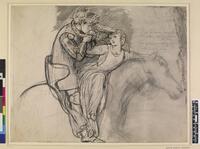 La Belle Dame sans Merci
La Belle Dame sans Merci Unfinished drawing showing a knight and a lady on horseback. The knight is kissing the lady's right hand and her hair is wrapped around his neck, resembling Lilith's strangling hair motif. The fifth stanza of a poem by Keats is written in pencil on the right side: "I set her on my pacing steed/ And nothing else saw all day long/ For sideways would she lean & sing/ A fairies' song."
-
 Magical Gem Intaglio
Magical Gem Intaglio Sketch representing a Roman two-sided magical gem (amulet) with engravings. Side A shows King Solomon riding a horse while stabbing a defenseless Lilith with a spear. Solomon is wearing a crown, tunic, and boots and Lilith is depicted with long hair. There is an eight-pointed star next to Solomon's head. Side B includes a beveled edge, several magical symbols and a Greek inscription translated as "Seal of God."
-
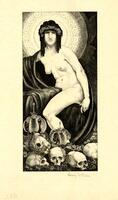 Lilith (Print)
Lilith (Print) A print depicting a nude Lilith sitting on drapery, surrounded by lilies and skulls. She is wearing a flower crown and there is a decorative, circular pattern behind her head. Henry Keen signed and titled the print ("Lilith") at the bottom.
-
 Figure-Mould
Figure-Mould A clay mold of a nude figure (possibly representing Ishtar or Lilith), with a horned crown, talon feet, and wings. This is a smaller, mass-produced version of the Burney Relief/ "Queen of the Night" separated in half.
-
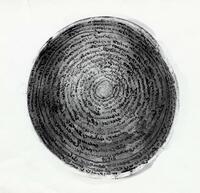 Incantation Bowl
Incantation Bowl A flat-based, wheel-thrown pottery incantation bowl with Mandaic text written in a spiral outwards and continuing on the outside of the bowl. The text includes three incantations, and the first is meant to protect Bashniray, the daughter of Shahafrid, against a lilith (or demoness). The last two relate to the health of Bashniray and her family.
-
 Base for a Statuette
Base for a Statuette A miniature boxwood base, likely created to support a statuette of the Virgin Mary. It is decorated with carvings of Eve and the snake (depicted as Lilith) in the Garden of Eden, separated by the apple tree. Eve is depicted eating an apple and there are flower carvings above and below the two figures.
-
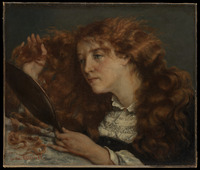 Jo, La Belle Irlandaise
Jo, La Belle Irlandaise This is a portrait of the model Joanna Hiffernan, who happened to be the mistress of one of Courbet's friends. This painting represents beauty and takes inspiration from earlier art styles to portray vanity as well. The painting depicts a woman with long red hair gazing into a hand-held mirror.
-
 Lady Lilith (Original)
Lady Lilith (Original) This was the original "Lady Lilith" completed by Rossetti, depicting a Victorian interpretation of the mythological figure Lilith in the same provocative style and background as the original painting. Lilith is shown with red hair and bare shoulders, gazing vainly at her reflection and combing her hair. The frame bears the title "Lady Lilith" and Rossetti's sonnet titled "My Lady Lilith" is inscribed:
"Of Adam's first wife, Lilith, it is told
(The witch he loved before the gift of Eve,)/
That, ere the snake's, her sweet tongue could deceive/
And her enchanted hair was the first gold/
And still she sits, young while the earth is old/
And, subtly of herself contemplative/
Draws men to watch the bright web she can weave/
Till heart and body and life are in its hold/
The rose and poppy are her flowers; for where/
Is he not found, O Lilith, whom shed scent/
And soft-shed kisses and soft sleep shall snare?/
Lo! as that youth's eyes burned at thine, so went/
Thy spell through him, and left his straight neck bent/
And round his heart one strangling golden hair."
-
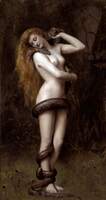 Lilith
Lilith This painting represents a nude Lilith with blonde hair and two snakes coiled around her legs and torso. The background is a dark, contrasting jungle theme with brown palm leaves and dark green grass at Lilith's feet.
-
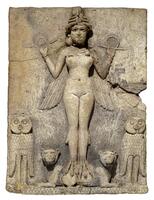 Burney Relief / The Queen of the Night
Burney Relief / The Queen of the Night This rectangular fired clay plaque was hand-modelled in relief to depict a female figure with talons and feathered wings, a horned headdress, and a necklace. The nude figure is holding a rod and a ring in each hand, and is holding her hands at shoulder level. There are scales, lions, and owls surrounding the figure, which is thought to depict Ishtar or Lilith. The plaque has been repaired and was once covered in red, black, and white pigments.
-
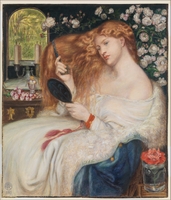 Lady Lilith
Lady Lilith This painting depicts Lilith, a Jewish mythological figure, as a 19th century "femme fatale" with long red hair and exposed shoulders, surrounded by a variety of white, pink, and red flowers representing different kinds of love. Lilith is combing her hair and gazing into a mirror, symbolizing vanity. This is the second version of this painting by Rossetti, as the first Lilith was given a different face at the commissioner's request. The original model for Lilith was Rossetti's mistress, Fanny Cornforth, and her face is seen in this version. The original frame encasing this painting has a label that quotes Goethe's Faust: “Beware . . . for she excels all women in the magic of her locks, and when she twines them round a young man’s neck, she will not ever set him free again.”
 Shaelyn Fett Photograph of Shaelyn Fett
Shaelyn Fett Photograph of Shaelyn Fett The Night-Hag Visiting Lapland Witches Painting illustrating a scene from Paradise Lost where hellhounds and night-hags are described: "follow the night-hag when, called, / In secret, riding through the air she comes, Lured with the smell of infant blood, to dance / With Lapland witches, while the laboring moon Eclipses at their charms." The night-hag (or succubus) is the focus of this painting and she is portrayed nude with grey skin and wild, unkempt hair, hovering over an infant she intends to kill or consume. She is looking over her shoulder at the lighter section of the night sky, the incoming hellhounds, and dancing witches. There are two hands holding onto a ladder and a sharp knife in the foreground.
The Night-Hag Visiting Lapland Witches Painting illustrating a scene from Paradise Lost where hellhounds and night-hags are described: "follow the night-hag when, called, / In secret, riding through the air she comes, Lured with the smell of infant blood, to dance / With Lapland witches, while the laboring moon Eclipses at their charms." The night-hag (or succubus) is the focus of this painting and she is portrayed nude with grey skin and wild, unkempt hair, hovering over an infant she intends to kill or consume. She is looking over her shoulder at the lighter section of the night sky, the incoming hellhounds, and dancing witches. There are two hands holding onto a ladder and a sharp knife in the foreground. The Great Isaiah Scroll Manuscript A of the complete Book of Isaiah (one of the seven Dead Sea Scrolls found in 1947). This scroll contains all 66 chapters and 54 columns, and is well-preserved. The excerpt from the Hebrew Bible that refers to Lilith is also visible on the scroll: “The wild-cat shall meet with the jackals and the satyr shall cry to his fellow, Yea, Lilith shall repose there and find her a place of rest” (Isaiah 34:14).
The Great Isaiah Scroll Manuscript A of the complete Book of Isaiah (one of the seven Dead Sea Scrolls found in 1947). This scroll contains all 66 chapters and 54 columns, and is well-preserved. The excerpt from the Hebrew Bible that refers to Lilith is also visible on the scroll: “The wild-cat shall meet with the jackals and the satyr shall cry to his fellow, Yea, Lilith shall repose there and find her a place of rest” (Isaiah 34:14). Amulet for mother and newborn with the names of Lilith and the three angels Amulet created to protect a mother and her newborn child from Lilith by evoking the three angels Senoy, Sansenoy, and Semangelof. The amulet drawing is a circular pattern with layers of writing and flower designs in black, yellow, and red. The background and center feature the color blue.
Amulet for mother and newborn with the names of Lilith and the three angels Amulet created to protect a mother and her newborn child from Lilith by evoking the three angels Senoy, Sansenoy, and Semangelof. The amulet drawing is a circular pattern with layers of writing and flower designs in black, yellow, and red. The background and center feature the color blue. Part of Tablet VI (Epic of Gilgamesh) Part of a Neo-Assyrian clay tablet inscribed with a section of Tablet VI of the Epic of Gilgamesh (written in cuneiform script). This section details a conversation between Ishtar and Gilgamesh, as well as the bull of heaven.
Part of Tablet VI (Epic of Gilgamesh) Part of a Neo-Assyrian clay tablet inscribed with a section of Tablet VI of the Epic of Gilgamesh (written in cuneiform script). This section details a conversation between Ishtar and Gilgamesh, as well as the bull of heaven. Tablet XII (Epic of Gilgamesh) A cuneiform literary tablet detailing the 12th part of the Epic of Gilgamesh, in which Lilith is referred to as a "shrieking" demoness. The picture provided is a sketched recreation of the tablet, which is broken into 6 pieces.
Tablet XII (Epic of Gilgamesh) A cuneiform literary tablet detailing the 12th part of the Epic of Gilgamesh, in which Lilith is referred to as a "shrieking" demoness. The picture provided is a sketched recreation of the tablet, which is broken into 6 pieces. Incantation Bowl Flat-based pottery incantation bowl with simple rim and flared wall. It is inscribed with Aramaic incantation text in a spiral from the inside to the rim, expelling demons including "liliths" (demonesses). The figure in the center might be Lilith herself, as she is often depicted on similar incantation bowls with long hair and chains to imprison her. The original client was Bahram Gushnasp, son of Ashtad Anahid.
Incantation Bowl Flat-based pottery incantation bowl with simple rim and flared wall. It is inscribed with Aramaic incantation text in a spiral from the inside to the rim, expelling demons including "liliths" (demonesses). The figure in the center might be Lilith herself, as she is often depicted on similar incantation bowls with long hair and chains to imprison her. The original client was Bahram Gushnasp, son of Ashtad Anahid. Amulet with a Lamashtu demon Lamashtu, a Mesopotamian goddess, is depicted with a muscular human body, the head of a lion-griffin, and the arms of a lion, pointed upright. She is surrounded by adult animals and offerings of a spindle, a comb, and a pin. An inscription in cuneiform is written around Lamashtu and on the back of the amulet, meant to imprison her and call upon other gods to expel her. In these inscriptions she is addressed as "exalted lady." The top left corner of the obsidian amulet has broken off.
Amulet with a Lamashtu demon Lamashtu, a Mesopotamian goddess, is depicted with a muscular human body, the head of a lion-griffin, and the arms of a lion, pointed upright. She is surrounded by adult animals and offerings of a spindle, a comb, and a pin. An inscription in cuneiform is written around Lamashtu and on the back of the amulet, meant to imprison her and call upon other gods to expel her. In these inscriptions she is addressed as "exalted lady." The top left corner of the obsidian amulet has broken off. Goddess Kali The Hindu goddess Kali Ma is depicted as a young woman with a blue-black complexion, long flowing hair, four arms, a necklace of severed heads and a belt of severed limbs. She is standing on the corpse of her husband, Shiva, with a bloody sacrificial sword in her hand. There is a ghostly, monochrome scene in the background.
Goddess Kali The Hindu goddess Kali Ma is depicted as a young woman with a blue-black complexion, long flowing hair, four arms, a necklace of severed heads and a belt of severed limbs. She is standing on the corpse of her husband, Shiva, with a bloody sacrificial sword in her hand. There is a ghostly, monochrome scene in the background. Lilith, Adam's first wife Woodcut depicting a scene from Goethe's Faust. Lilith is seen with long hair, a long dress, and barefoot. She is walking past a wild boar and Mephistopheles and Faust are discussing her in the background (top right corner). Barlach signed his name in the bottom right corner.
Lilith, Adam's first wife Woodcut depicting a scene from Goethe's Faust. Lilith is seen with long hair, a long dress, and barefoot. She is walking past a wild boar and Mephistopheles and Faust are discussing her in the background (top right corner). Barlach signed his name in the bottom right corner. La Belle Dame sans Merci Unfinished drawing showing a knight and a lady on horseback. The knight is kissing the lady's right hand and her hair is wrapped around his neck, resembling Lilith's strangling hair motif. The fifth stanza of a poem by Keats is written in pencil on the right side: "I set her on my pacing steed/ And nothing else saw all day long/ For sideways would she lean & sing/ A fairies' song."
La Belle Dame sans Merci Unfinished drawing showing a knight and a lady on horseback. The knight is kissing the lady's right hand and her hair is wrapped around his neck, resembling Lilith's strangling hair motif. The fifth stanza of a poem by Keats is written in pencil on the right side: "I set her on my pacing steed/ And nothing else saw all day long/ For sideways would she lean & sing/ A fairies' song." Magical Gem Intaglio Sketch representing a Roman two-sided magical gem (amulet) with engravings. Side A shows King Solomon riding a horse while stabbing a defenseless Lilith with a spear. Solomon is wearing a crown, tunic, and boots and Lilith is depicted with long hair. There is an eight-pointed star next to Solomon's head. Side B includes a beveled edge, several magical symbols and a Greek inscription translated as "Seal of God."
Magical Gem Intaglio Sketch representing a Roman two-sided magical gem (amulet) with engravings. Side A shows King Solomon riding a horse while stabbing a defenseless Lilith with a spear. Solomon is wearing a crown, tunic, and boots and Lilith is depicted with long hair. There is an eight-pointed star next to Solomon's head. Side B includes a beveled edge, several magical symbols and a Greek inscription translated as "Seal of God." Lilith (Print) A print depicting a nude Lilith sitting on drapery, surrounded by lilies and skulls. She is wearing a flower crown and there is a decorative, circular pattern behind her head. Henry Keen signed and titled the print ("Lilith") at the bottom.
Lilith (Print) A print depicting a nude Lilith sitting on drapery, surrounded by lilies and skulls. She is wearing a flower crown and there is a decorative, circular pattern behind her head. Henry Keen signed and titled the print ("Lilith") at the bottom. Figure-Mould A clay mold of a nude figure (possibly representing Ishtar or Lilith), with a horned crown, talon feet, and wings. This is a smaller, mass-produced version of the Burney Relief/ "Queen of the Night" separated in half.
Figure-Mould A clay mold of a nude figure (possibly representing Ishtar or Lilith), with a horned crown, talon feet, and wings. This is a smaller, mass-produced version of the Burney Relief/ "Queen of the Night" separated in half. Incantation Bowl A flat-based, wheel-thrown pottery incantation bowl with Mandaic text written in a spiral outwards and continuing on the outside of the bowl. The text includes three incantations, and the first is meant to protect Bashniray, the daughter of Shahafrid, against a lilith (or demoness). The last two relate to the health of Bashniray and her family.
Incantation Bowl A flat-based, wheel-thrown pottery incantation bowl with Mandaic text written in a spiral outwards and continuing on the outside of the bowl. The text includes three incantations, and the first is meant to protect Bashniray, the daughter of Shahafrid, against a lilith (or demoness). The last two relate to the health of Bashniray and her family. Base for a Statuette A miniature boxwood base, likely created to support a statuette of the Virgin Mary. It is decorated with carvings of Eve and the snake (depicted as Lilith) in the Garden of Eden, separated by the apple tree. Eve is depicted eating an apple and there are flower carvings above and below the two figures.
Base for a Statuette A miniature boxwood base, likely created to support a statuette of the Virgin Mary. It is decorated with carvings of Eve and the snake (depicted as Lilith) in the Garden of Eden, separated by the apple tree. Eve is depicted eating an apple and there are flower carvings above and below the two figures. Jo, La Belle Irlandaise This is a portrait of the model Joanna Hiffernan, who happened to be the mistress of one of Courbet's friends. This painting represents beauty and takes inspiration from earlier art styles to portray vanity as well. The painting depicts a woman with long red hair gazing into a hand-held mirror.
Jo, La Belle Irlandaise This is a portrait of the model Joanna Hiffernan, who happened to be the mistress of one of Courbet's friends. This painting represents beauty and takes inspiration from earlier art styles to portray vanity as well. The painting depicts a woman with long red hair gazing into a hand-held mirror. Lady Lilith (Original) This was the original "Lady Lilith" completed by Rossetti, depicting a Victorian interpretation of the mythological figure Lilith in the same provocative style and background as the original painting. Lilith is shown with red hair and bare shoulders, gazing vainly at her reflection and combing her hair. The frame bears the title "Lady Lilith" and Rossetti's sonnet titled "My Lady Lilith" is inscribed: "Of Adam's first wife, Lilith, it is told (The witch he loved before the gift of Eve,)/ That, ere the snake's, her sweet tongue could deceive/ And her enchanted hair was the first gold/ And still she sits, young while the earth is old/ And, subtly of herself contemplative/ Draws men to watch the bright web she can weave/ Till heart and body and life are in its hold/ The rose and poppy are her flowers; for where/ Is he not found, O Lilith, whom shed scent/ And soft-shed kisses and soft sleep shall snare?/ Lo! as that youth's eyes burned at thine, so went/ Thy spell through him, and left his straight neck bent/ And round his heart one strangling golden hair."
Lady Lilith (Original) This was the original "Lady Lilith" completed by Rossetti, depicting a Victorian interpretation of the mythological figure Lilith in the same provocative style and background as the original painting. Lilith is shown with red hair and bare shoulders, gazing vainly at her reflection and combing her hair. The frame bears the title "Lady Lilith" and Rossetti's sonnet titled "My Lady Lilith" is inscribed: "Of Adam's first wife, Lilith, it is told (The witch he loved before the gift of Eve,)/ That, ere the snake's, her sweet tongue could deceive/ And her enchanted hair was the first gold/ And still she sits, young while the earth is old/ And, subtly of herself contemplative/ Draws men to watch the bright web she can weave/ Till heart and body and life are in its hold/ The rose and poppy are her flowers; for where/ Is he not found, O Lilith, whom shed scent/ And soft-shed kisses and soft sleep shall snare?/ Lo! as that youth's eyes burned at thine, so went/ Thy spell through him, and left his straight neck bent/ And round his heart one strangling golden hair." Lilith This painting represents a nude Lilith with blonde hair and two snakes coiled around her legs and torso. The background is a dark, contrasting jungle theme with brown palm leaves and dark green grass at Lilith's feet.
Lilith This painting represents a nude Lilith with blonde hair and two snakes coiled around her legs and torso. The background is a dark, contrasting jungle theme with brown palm leaves and dark green grass at Lilith's feet. Burney Relief / The Queen of the Night This rectangular fired clay plaque was hand-modelled in relief to depict a female figure with talons and feathered wings, a horned headdress, and a necklace. The nude figure is holding a rod and a ring in each hand, and is holding her hands at shoulder level. There are scales, lions, and owls surrounding the figure, which is thought to depict Ishtar or Lilith. The plaque has been repaired and was once covered in red, black, and white pigments.
Burney Relief / The Queen of the Night This rectangular fired clay plaque was hand-modelled in relief to depict a female figure with talons and feathered wings, a horned headdress, and a necklace. The nude figure is holding a rod and a ring in each hand, and is holding her hands at shoulder level. There are scales, lions, and owls surrounding the figure, which is thought to depict Ishtar or Lilith. The plaque has been repaired and was once covered in red, black, and white pigments. Lady Lilith This painting depicts Lilith, a Jewish mythological figure, as a 19th century "femme fatale" with long red hair and exposed shoulders, surrounded by a variety of white, pink, and red flowers representing different kinds of love. Lilith is combing her hair and gazing into a mirror, symbolizing vanity. This is the second version of this painting by Rossetti, as the first Lilith was given a different face at the commissioner's request. The original model for Lilith was Rossetti's mistress, Fanny Cornforth, and her face is seen in this version. The original frame encasing this painting has a label that quotes Goethe's Faust: “Beware . . . for she excels all women in the magic of her locks, and when she twines them round a young man’s neck, she will not ever set him free again.”
Lady Lilith This painting depicts Lilith, a Jewish mythological figure, as a 19th century "femme fatale" with long red hair and exposed shoulders, surrounded by a variety of white, pink, and red flowers representing different kinds of love. Lilith is combing her hair and gazing into a mirror, symbolizing vanity. This is the second version of this painting by Rossetti, as the first Lilith was given a different face at the commissioner's request. The original model for Lilith was Rossetti's mistress, Fanny Cornforth, and her face is seen in this version. The original frame encasing this painting has a label that quotes Goethe's Faust: “Beware . . . for she excels all women in the magic of her locks, and when she twines them round a young man’s neck, she will not ever set him free again.”